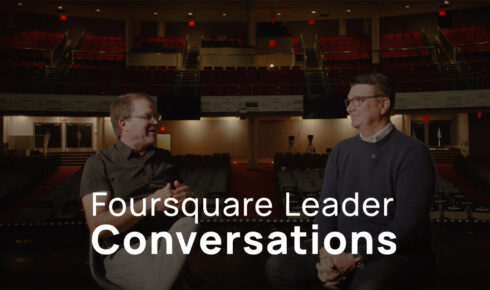When I was 27, I became senior pastor of an amazing church in Washington State. I had been the youth pastor for five years prior. For the entire life of the church, we had been portable, setting up and tearing down in various locations, such as the grange hall, library and schools. Like the Israelites, we would move our tents wherever the presence of God led us (or wherever we could find cheaper rent).
Shortly after accepting the pastorate, I began to look around town at vacant facilities that could house our growing congregation. We had overstayed our welcome at the local middle school and needed to find permanent digs. Questions emerged: Where? What will it cost? Do we build from scratch or remodel something existing?
In looking for a meeting place, I remembered a vacant drug store in the center of the city. We met with a relator and looked inside. And so, at 27, I went into my first council meeting as the new senior pastor and presented the proposal of purchasing a $750,000 shell of a building.
We went on to purchase that facility, and engaged in an architectural process and a full remodel. It was a really exciting time for our church and its young pastor. Actually, let me be frank: I was scared and didn’t have a clue what I was doing.
But I did have a simple, confirming word from the Lord: “John, this will be a no-brainer in terms of your future and the future of this church. This will pave the way for bigger decisions, facilities, budgets and issues that you will deal with. Learn everything you can now so that you are better prepared for the future.”
God was right. I would learn a few things. Here are some of the lessons gained in my first building project as a 27-year-old senior pastor.
No. 1: It’ll Take Longer Than You Think
Every pastor wants the new building to be up and running by one of the biggest-attended services of the year, such as Easter, which my buddies and I call Super Bowl Sunday for church. We want our community to walk into a freshly painted, tastefully decorated, newly unveiled facility and say: “Wow, this is amazing! We’ll be back next week!”
Well, it didn’t happen by a long shot. Easter came and went. Six months later, we finally got a conditional use permit to meet in the building. But it didn’t have carpet, staging or paint.
The lesson for me was to set realistic goals and then be flexible. It’s like going on an overseas missions trip. No matter how many plans you make, it never goes as anticipated. Something will invariably go wrong or slow things down. Go with the flow and trust God’s sovereignty in these matters.
No. 2: It’s Best to Stick to Preaching
One day during the remodel, the general contractor challenged me: “You know, Pastor, God has given us both tools. He gave you a Bible, and He gave me a hammer. Let me use my hammer to build this church, so that you can use your Bible to build it too.” In a nutshell, he was saying: “Get outta here so we can both do our jobs!”
My driving thought had been that if I was onsite every day, the project would get done more quickly. I would often get in the middle of it all with the singular goal of “spurring one another unto love and … a finished church.”
The lesson for me was to let the builders build, the painters paint and the preachers preach. A general contractor is worth his or her weight in gold-tipped framing nails.
Don’t buy into the garbage that the senior pastor would make the best general contractor. You make the best senior pastor; believe me, to try to do both effectively is ministry suicide and ultimately doesn’t serve the church very well.
No. 3: Measure Twice, Cut Once
I picked up this carpenter’s slogan during our remodel project: “Measure twice, cut once.” This makes good sense. It’s always regrettable when a project moves too fast and key aspects are overlooked.
One of the lessons I learned was that we should have taken a little extra time and spent a little extra money in the beginning to design and equip our facility exactly the way we wanted. In an effort to save a little bit of money and speed up the process, we sacrificed important functions and took shortcuts. Going back and trying to retrofit things ultimately cost the church much more than if we had done it properly to begin with.
No. 4: Prepare for Sticker Shock
Count on this: The project will cost at least $100,000 more than you planned on spending. Note the key words: “at least.” No matter how you slice it, dice it or spreadsheet it, you will likely be over budget.
This can happen for an array of reasons. Perhaps certain aspects of the project weren’t thought of initially. Maybe the cost of materials went up during the process. In the case of remodels, challenges might be uncovered as you go, such as finding layers of dry rot.
Plan for it. Pray about it. Talk it over often with your leadership so it can be both expected and funded in a healthy, non-threatening way. It would be so unfortunate to get down to the wire and not be able to finish the project or occupy the property.
No. 5: Limit the Size of Committees
If only our people would take as great an interest in the doctrine of sanctification or justification as they do in the color, grade, cost and consistency of the sanctuary carpet! Thankfully, the congregation I was serving gave very little input into the carpet choice.
It was, however, enough of an issue that I was led to create a policy regarding the choosing of carpet. It is drawn directly from Scripture: “For where two or three are gathered together in My name, I am there in the midst of them” (Matt. 18:20, NKJV).
I realize this is a radical misinterpretation of this passage, but don’t miss the lesson I learned. Limit the size of the group to choose carpet (and many other decisions) to “two or three,” and that is it. This group size is perfect for decision-making. It doesn’t need to be a huge committee (or, worse yet, the whole congregation), and choices aren’t left to the whim of one.
These are a few of the many lessons gained in my first pastorate. God was right when he spoke those vital words to my heart about how they would prepare me for the future.
You see, in 2008, we accepted a call from the Lord to assume the pastorate of a larger congregation in Oregon. This congregation had just moved into a new, large facility. The cost for the church campus was substantial, and the debt was great. I entered into a season of bigger decisions, facilities, budgets and issues.
I am grateful to the Lord for teaching me lessons along the way. Like King David, I gained the wisdom and courage to take on the “Goliaths” from taking on the “bears and lions.”
By: John Fehlen, senior pastor of West Salem Foursquare Church in Salem, Ore.


